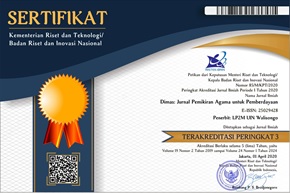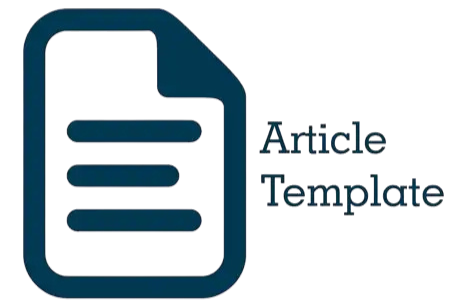Preservation of Community Values: Study of the Samin Bojonegoro Teaching Transformation Model Through the Education Unit Curriculum
DOI:
https://doi.org/10.21580/dms.2023.231.13322Keywords:
Samin, educational transformation, social transformation, community developmentAbstract
This article explains the process of instilling values, which is carried out by internalizing community teachings through educational units. The internalization of values is achieved by inserting Samin's noble pitutur in PAI and PPKn subjects at elementary, middle and high school levels. The choice of this educational institution indicates that schools have a strategic role in preserving values. This participatory action research was conducted in Dusun, Japan, a hamlet inhabited by the Samin Bojonegoro community. This community adheres to the teachings of its ancestors. However, on the other hand, the openness in this community also allows for a permissive attitude, which has the potential to erode the strength of their traditions. The research was carried out for four months, starting with problem mapping, problem analysis and action involving traditional stakeholders, policy stakeholders and education stakeholders. The choice of action taken is to insert community values through Islamic Religious Education and Character subjects and Pancasila and Citizenship Education subjects. This insertion is a cultural preservation strategy that stakeholders consider to be the right step because, through this institution, children can internalize the noble values that exist around them.
Downloads
References
Basuki, A. P. (2011). Peran Pemerintah Daerah Kabupaten Banyuwangi dalam Pelestarian dan Pengembangan Kebudayaan Masyarakat Using [Skripsi]. Universitas Jember.
Benda, H. J., & Castles, L. (1969). The Samin Movement. Bijdragen Tot de Taal-, Land- En Volkenkunde, 125(2), 207–240.
Cahyono, A. S. (2016). Pengaruh Media Sosial Terhadap Perubahan Sosial Masyarakat Di Indonesia. Publiciana, 9(1), Article 1. https://doi.org/10.36563/¬publi¬ciana.v9i1.79
Fauzia, A., & Kahija, Y. F. L. (2019). Arti Memelihara Tradisi Pada Suku Samin. Jurnal EMPATI, 8(1), Article 1. https://doi.org/10.14710/empati.2019.23598
Haerah, K., & Argarini, Z. (2017). Peran Pemerintah Desa Dalam Melestarikan Budaya Tari Seblang (Study Kasus Di Desa Olehsari Kecamatan Glagah, Kabupaten Banyuwangi). Politico, 17(1), Article 1. https://doi.org/10.32528/¬politico¬.¬v17i1.735
Hafidz. (2022, July 24). [Personal communication].
Hidayati, N. A., & Shofwani, S. A. (2019). Pemertahanan Identitas Karakter Budaya Masyarakat Samin di Desa Margomulyo Bojonegoro. KREDO : Jurnal Ilmiah Bahasa dan Sastra, 3(1), Article 1. https://doi.org/10.24176/kredo.v3i1.4020
Huda, K., & Wibowo, A. M. (2013). Interaksi Sosial Suku Samin Dengan Masyarakat Sekitar (Studi Di Dusun Jepang Desa Margomulyo Kecamatan Margomulyo Kabupaten Bojonegoro Tahun 1990-2012). Agastya: Jurnal Sejarah Dan Pembelajarannya, 3(01), Article 01. https://doi.org/10.25273/ajsp.v3i01.907
Hutomo, S. S. (1985). Samin Surosentiko dan Ajaran-ajarannya. Majalah Basis, XXXIV(1 & 2).
Irianto, A. M. (2016). Komodifikasi Budaya Di Era Ekonomi Global Terhadap Kearifan Lokal: Studi Kasus Eksistensi Industri Pariwisata dan Kesenian Tradisional di Jawa Tengah. Jurnal Theologia, 27(1), Article 1. https://doi.org/10.21580/-teo.2016.27.1.935
Kirom, S. (2020). Sejarah Masyarakat Samin 1890-1919: Perspektif Wilhelm Dilthey. Jurnal Tamaddun : Jurnal Sejarah Dan Kebudayaan Islam, 8(1), Article 1. https://doi.org/10.24235/tamaddun.v8i1.5984
Lukito, J. (2022, May 21). [Personal communication].
Mikkelsen, B. (2011). Metode Penelitian Partisipatoris dan Upaya Pemberdayaan: Panduan Bagi Praktisi Lapangan. Pustaka Obor.
Mukodi, & Burhanuddin, A. (2017). Pengembangan Kurikulum Muatan Lokal berbasis Ajaran Samin Surosentiko. Seminar Nasional Hasil Penelitian.
Niam, K. (2008, 27 Agustus). Pendidikan dan Perubahan Sosial: Konteks Sosio-Historis Pendidikan Islam, Sebuah Refleksi Dialektis. Halaqah Nasional Pendidikan, Surabaya.
Nurdin, N., & Adzkiya’, U. (2021). Tradisi perlawanan kultural masyarakat samin. Jurnal Sosiologi Agama, 15(1), Article 1. https://doi.org/10.14421/jsa.¬2021.151-05
Nurkasanah, R. S. (2020). Makna pendidikan formal dan ajaran samin di Desa Sambongrejo Kecamatan Sambong Kabupaten Blora / Rohana Siti Nurkasanah [Diploma, Universitas Negeri Malang]. http://repository.um.ac.id/140504/
Nurkasanah, R. S., Purnomo, A., & Kurniawan, B. (2021). Makna Pendidikan dan Pewarisan Ajaran Samin bagi Masyarakat di Desa Sambongrejo Kecamatan Sambong Kabupaten Blora. Jurnal Sosiologi Pendidikan Humanis, 6(2), Article 2. https://doi.org/10.17977/um021v6i2p108-118
Nuryanto. (2022, May 28). [Personal communication].
Permendiknas tentang Standar Kualifikasi Akademik dan Kompetensi Guru, Pub. L. No. 16 (2007).
Pinasti, V. I. S., & Lestari, P. (2017). Masyarakat Samin Ditinjau dari Sejarah dan Nilai-Nilai Pendidikan Karakter. 13(2).
Rafiq, A. (2020). Dampak Media Sosial terhadap Perubahan Suatu Masyarakat. 1(1). https://ejournal.upnvj.ac.id/index.php/GlobalKomunika/article/view/1704
Rahmat, A., & Mirnawati, M. (2020). Model Participation Action Research Dalam Pemberdayaan Masyarakat. 6(1).
Rosyid, M. (2018). Upaya Komunitas Samin Di Kudus Jawa Tengah Dalam Mempertahankan Jati Diri Di Tengah Problematika Kehidupannya. Masyarakat Indonesia, 42(2), Article 2. https://doi.org/10.14203/jmi.v42i2.670
Rosyid, M. (2020). Agama Adam dan Peribadatan dalam Ajaran Samin. Jurnal Sosiologi Agama Indonesia (JSAI), 1(2), Article 2. https://doi.org/1¬0.22373/jsai.v1i2.500
Sari, P. P., & Basit, L. (2018). Komunikasi Organisasi Kepala Desa Dalam Membangun Kesadaran Masyarakat Desa Terhadap Pembangunan Desa. Jurnal Interaksi : Jurnal Ilmu Komunikasi, 2(1), Article 1. https://doi.org/10.30596/interaksi.¬v2i1.1787
Sulanam, & Huda, M. N. (2022). FGD Pemetaan Kompetensi dan Insersi Nilai Samin melalui Mata Pelajaran PAI dan PPKn.
Suradi. (2022, May 29). [Personal communication].
Suradi, A. (2018). Pendidikan Berbasis Multikultural dalam Pelestarian Kebudayaan Lokal Nusantara di era Globalisasi. 5(1). https://jurnal.unimed.ac.id/2012/-index.php/jupiis/article/view/8831
Sutrisno, B. (2022, May 30). [Personal communication].
Undang-undang tentang Guru dan Dosen, No. 14 (2005).
Wahyuni, S. (2015). Tinjauan Historis-Sosiologis Perkawinan Adat Masyarakat Samin Di Betu Rejo Sukolilo Pati Jawa Tengah. 3(2).
Wardoyo, S., Wulandari, T., Guntur, G., Dharsono, D., & Zulkarnain, Z. (2021). Penciptaan Selendang Batik Sri Kuncoro Khas Budaya Samin Margomulyo Bojonegoro. Gorga : Jurnal Seni Rupa, 10(2), Article 2. https://doi.org/¬10.24114/gr.v10i2.28123
Wibawa, M. Y. A., & Syafiq, M. (2021). Gambaran Identitas Sosial Anggota Keluarga Suku Samin. 8(2). https://ejournal.unesa.ac.id
Downloads
Published
Issue
Section
License
Copyright
The copyright of the received article shall be assigned to the journal as the publisher of the journal. The intended copyright includes the right to publish the article in various forms (including reprints). The journal maintains the publishing rights to the published articles. Therefore, the author must submit a statement of the Copyright Transfer Agreement.*)
Licensing

This work is licensed under a Creative Commons Attribution-ShareAlike 4.0 International License.
In line with the license, authors are allowed to share and adapt the material. In addition, the material must be given appropriate credit, provided with a link to the license, and indicated if changes were made. If authors remix, transform or build upon the material, authors must distribute their contributions under the same license as the original.
_______
*) Authors whose articles are accepted for publication will receive confirmation via email and send a Copyright Transfer Agreement.









